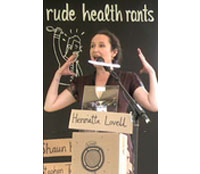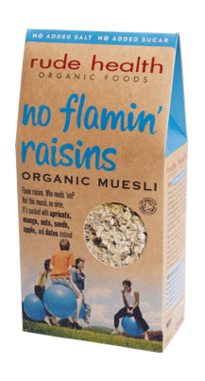Social media case study
10 May 2010 By Northern Lights

We have been commissioned to run a number of workshops for smaller businesses and have been looking for case studies about the benefits of social media and how it is being used. Camilla Barnard at Rude Health talked to us about how they are using Twitter and Facebook for their business.
Rude Health’s experience and tips back up our own recommendations about social media for businesses
– Social media is just part of the communications mix – it is one route to communicate with some audiences
– For most businesses it is unlikely to drive sales traffic on its own
– It is an excellent way to talk to your customers and understand them in more depth
– You can use social media for informal and immediate market research
Camilla has kindly allowed us to share Rude Health’s story here.![]()
Social media at Rude Health
Rude Health was established in 2005 by four friends with young children who liked wholesome and nutritious food and focused on healthy breakfasts.
Camilla Barnard was one of the founders and started using various social media – Twitter, Facebook and a ‘teeny bit of Linkedin’ – from early 2009.
They did not have a formal social media strategy but saw it as part of the whole PR and marketing mix: “We saw this as a great way to speak up for good health, stand out in the health cereals market and demonstrate that we have a serious point of view.”
1. What kind of Tweets?
From the start, Camilla has tweeted (ie written or ‘posted’ comments on her Twitter feed) about their cereals and the wider organic foods market and issues. Taking a day’s snapshot of tweets, these include (*see below for a glossary of terms used in here)
– Retweeting the Soil Association’s comments about a report showing that the use of pesticides on genetically modified crops has risen dramatically – with a link to the report
– Replied to @saladclub who had tweeted ‘wondering what to do for pre-work daily breakfast. that’s the hard part! proving v challenging’. Of course Camilla sent a tweet saying ‘Porridge made with water or non-dairy milk stuff, topped with stewed fruits. Beat that’
– ‘Tweet conversations’ with @porridgelady who has become a big fan of Rude Health’s products and mentions that Rude Health will be at the Real Food Festival
– Retweeting the post from @brockhallfarm which said ‘The Granola by @rudehealth is gorgeous; not too sweet, fab ingredients incl spelt & amaranth,result in a mellow lightness’
– Retweeted a number of posts from fellow good food suppliers such as Breckland and Real Bread
2. Use Twitter to drive interest ahead of an exhibition
There are also a number of posts about ‘rants’. Nick Barnard, another director, was always ranting in the office about everything from ‘marketing people make you think milk is full of fat’ to ‘cloudy apple juice has to be so much better than the clear stuff’.
Eventually the office told him to go and rant on the website – which he now does regularly under Nick’s rants. This has since become a feature of Rude Health’s stands at food fairs. They invite well known food personalities, other exhibitors and the public to come and have a rant, which then goes up on the website.
 Leading up to the fairs, there is plenty of material for conversations on Twitter and Facebook, such as ‘31 Ranters ready to let rip on all things foodie @RealFoodFest already’. A number who have signed up to rant have started tweeting about it ‘Looking forward to ranting away! http://bit.ly/9xocMB …….clear lemonade, who needs it!’
Leading up to the fairs, there is plenty of material for conversations on Twitter and Facebook, such as ‘31 Ranters ready to let rip on all things foodie @RealFoodFest already’. A number who have signed up to rant have started tweeting about it ‘Looking forward to ranting away! http://bit.ly/9xocMB …….clear lemonade, who needs it!’
3. Twitter for market research
Camilla has found Twitter an excellent way to carry out market research. She admits it is casual rather than rigorous – she could not use it to gauge a market accurately – but it is immediate and costs nothing.
She gives as an example, finding out what people think of new ingredients: “We might be sourcing a new type of berry but it is very expensive. So we might tweet ‘Anyone heard of this berry? Is it any good?’ Yes, responses will probably be biased but you can save a lot of time and money when you get a few replies either saying ‘this is gorgeous and worth every penny’ or ‘we used this in our breads last year and it was a real flop’.”
Camilla says that you cannot expect good responses from just one tweet – she will try and ask a question in a number of different ways over a day or so to catch a reasonable number of people.
Some of the tweets have led to new products being developed. A few foods such as bananas, hazelnuts and raisins are very divisive – people love them or hate them. This led to No Flamin’ Raisins – a muesli without the raisins.
Camilla adds other ways she uses Twitter for general research: “By following people who are specialised in particular things, whether it’s restaurant awards, nutrition or supermarkets, you find out what they are interested in by seeing what they are tweeting about. It’s a good way of keeping up with what’s new or cool. Especially if like me you never manage to read a paper or magazine.”
4. Twitter as a route to journalists and specialist bloggers
Rude Health has recognised that the new route to journalists and ranked bloggers is to tweet interesting information.
Camilla has found that journalists rarely follow the tweets or blogs from branded food businesses. However, they do follow food bloggers, such as the ones listed here, and find out about popular new foods from these:
Porridge Lady – cooks with oats
Scandilicious – cooking and feasting with Scandinavian flair
Meemalee – restaurants, reviews, rants
Youngandfoodish – restaurants, tasting reviews
Realbread – real bread campaign
Mathildecuisine – cooking around the world
Eatlikeagirl – cooking inspired by travels
The Porridge Lady has become a good friend of Rude Health’s and often joins up with them at food exhibitions to cook some of her winning recipes – and of course writing and tweeting about the experience.
Camilla was recently interviewed by Sheila Dillon for the BBC’s Food Programme and then featured with a weblink on the web page about the interview.
5. Making friends on Facebook
Setting up a page on Facebook was the first step that Rude Health took into social media at the end of 2008 and now have around 150 friends who follow what the company is doing.
Rude Health puts videos and photos on the site and has had three discussions:
- Raisins – LOVE them or HATE them?
- Win your Wednesday Breakfast – ‘tell us when you feel in rude health and we might put the best on our cereal packet’
- Say NO to ‘Ban the Flapjack’ campaign – former chief of Food Standards Agency was calling for a ban on flapjacks to curb obesity
Camilla points out that different social media can help in different ways: “Twitter is ideal if you can dip in and out of it throughout the day or evening. You can get iphone apps for it as well so it works well if you are often out. Facebook needs less regular attention, in my opinion.”
6. Does social media bring in new customers?
Camilla is absolutely certain that social media is worth doing – but, she emphasises that it should only ever be one part of marketing and communications for any business. She would be surprised if most businesses could rely on social media alone to generate customers.
She says it is very difficult to measure specific new customers from Twitter or Facebook: “I think the biggest benefits have come from developing relationships with loyal customers and influencers – in our case the food bloggers. It is a good way to tell our customers when we will be at an event, good to generate pre-event interest and it is a very cost effective way of carrying out some market research.
“Because we have been using social media for a while, Sheila Dillon interviewed us on the BBC Food Programme. The following week our website hits went from a typical 100 a day to 700 a day. And our direct sales from the website rose from around 2 orders a day to about 10 or 12 a day.”
But she points out that appearing on a national radio programme was really ‘traditional PR’ – the social media was just a new route to engaging with the journalist rather than through a press release. And website sales account for less than one per cent of their total sales.
“Our core business is about selling to independent retailers and supermarkets and in all honesty, social media has little direct impact on that process. However, I see it as an important part of the communications and PR process with our direct customers and journalists and I’m sure that is going to increase significantly over the next year or so.”
*Twitter Glossary – Common Terms
Taken from a variety of sources including About.com’s website – with thanks. These are some of the terms that are part of the everyday jargon used on Twitter
Hashtag The community-driven practice of tagging an individual tweet by using a hash in front of the tag. Example: Putting #dallascowboys in a tweet about the Dallas Cowboys. Hashtags allow the community to easily stream a particular subject
Microblog Twitter is often referred to as a microblog because it allows people to update their status using only 140 characters
Mistweet Accidentally sending a tweet to the wrong person or wishing you didn’t send a particular tweet
Retweet (RT) A Retweet is a repeated tweet. It is sometimes used in a reply to allow everyone to see the original tweet. It is also used to forward a message onto one’s own followers
Tweet A message sent via Twitter
Tweet Back Bringing an older tweet back into the converstation
Tweeter A person who tweets
Unfollow A common social networking term referring to the act of taking someone off of your friends list



